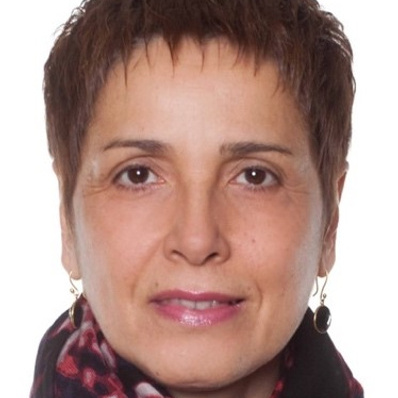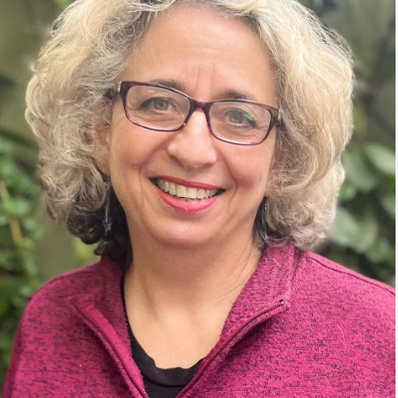

Robert (Bob) Sinclair is Professor of Materials Science and Engineering at Stanford University, USA. He has been a longtime member of the Microscopy Society of America, and has attended, and contributed to, IMC since ICEM-9 in Toronto. Bob was born in Liverpool, UK, and was brought up in the local area.


Joanne Etheridge is currently an Australian Research Council Georgina Sweet Laureate Fellow in the School of Physics and Astronomy at Monash University and the Science Director of the Monash Centre for Electron Microscopy. She obtained a degree and PhD in physics from the University of Melbourne and RMIT University, respectively, before appointments at the University of Cambridge in the Department of Materials Science and Metallurgy and Newnham College, including a Rosalind Franklin Research Fellowship and a Royal Society University Research Fellowship. She returned to Melbourne to join Monash University where she established the Monash Centre for Electron Microscopy. She conducts research in the theory and development of new electron scattering methods for determining the atomic and electronic structure of condensed matter. She also applies these methods to the study of structure-property relationships in functional materials. She is a Fellow of the Australian Academy of Science.


Julia Fernandez-Rodriguez is the Head of the National Centre for Cellular Imaging at the University of Gothenburg in Sweden, Head of the Integrated Microscopy Unit at the SciLifeLab Infrastructure in Gothenburg, and co-Director of the Swedish National Microscopy Infrastructure. She is deeply involved in shaping the landscape of imaging research both nationally and internationally. Additionally, Julia serves as the Vice-chair of the Panels of Node for the Euro-BioImaging-ERIC and President of the Core Technologies for Life Sciences Association.
Julia actively contributes to the European imaging community, serving on the Steering Committee of the European Light Microscopy Initiative (ELMI), being a member of The Global BioImage Analysts’ Society (GloBIAS), and participating as a partner in the EU-funded project Research Infrastructure Training (RItrainPlus).


Izzy is an Associate Professor and Department Head of Molecular Medicine, UNSW, and a UKRI Future Leader Fellow at the University of Sheffield (UK). She was awarded her PhD in 2011 at the University of Auckland for the early work applying localisation microscopy (STORM) to visualise the cardiac ryanodine receptor. Following two postdoctoral positions in the Universities of Queensland and Exeter, Izzy has led the Signalling Nanodomains Laboratory in Leeds, and more recently in Sheffield and Sydney. Over the past 10 years, Izzy and her team have specialised in correlative microscopies and some of the more recent super-resolution approaches such as expansion microscopy to study the intracellular calcium signalling machinery in excitable cells.
As a part of her UKRI fellowship, Izzy’s team in Sheffield have been developing and refining the tools, probes and analysis approaches that advance the uptake and validation of expansion microscopy. Izzy is a Fellow of the Royal Microscopical Society and works as an Associate Editor for The Royal Society’s Open Biology journal to champion sustainable academic publishing models. In 2023, she was named as one of New Zealand’s “40 under 40” as a ‘disruptor and innovator’. Outside of the research work, Izzy has worked to raise awareness of the lack of inclusion and equity in the high-education and STEM sectors through engaging with funding councils and the all-party parliamentary groups in the UK and Ireland.


Prof Zonghoon Lee leads the Atomic Scale Electron Microcopy group at Ulsan National Institute of Science and Technology (UNIST), South Korea, and served as the inaugural head of the Materials Science and Engineering Department for four years. He is a group leader of the co-affiliated Institute for Basic Science (IBS), Center for Multidimensional Carbon Materials. He founded the Atomic Imaging Center and the Center for Multidimensional Programmable Matter.
He has served as president of the Korean Society of Microscopy, the treasurer of the Committee of Asia Pacific Societies for Microscopy (CAPSM), and the editor-in-chief of Applied Microscopy journal published by Springer Nature. His research focuses on the atomic-scale characterization, design and synthesis, and properties of 2D materials, carbon nanomaterials, and soft matter using aberration-corrected S/TEM and spectroscopy. His studies include in situ TEM experiments at both the atomic and nanoscale. He has more than 200 journal publications with more than 18,000 citations in the field of materials science and electron microscopy.


Joachim Mayer received his Ph. D. in Physics at the Max-Planck-Institut für Metallforschung, Stuttgart, Germany. In 1988 he joined the Materials Department at the University of California, Santa Barbara, as a postdoctoral research associate. In 1990 he moved back to the Max-Planck-Institut für Metallforschung, Stuttgart, where he worked as a research scientist and Group Leader ‘Analytical Electron Microscopy’. In 1999 he joined RWTH Aachen University to become Professor and Head of the Central Facility for Electron Microscopy of RWTH Aachen. In 2004, he received a co-appointment as one of the two directors of the Ernst Ruska-Centre at Research Centre Juelich.


Maddy Parsons is Professor of Cell Biology, Director of Nikon Imaging Centre & Microscopy Innovation Centre, King’s College London. Parsons research focuses on understanding how mechanical and chemical cues influence cell behaviour and how these influence diseases such as cancer and fibrosis. Her work is highly interdisciplinary in nature, working with clinicians, physicists, engineers and computational scientists to implement advanced technological imaging-based solutions to understand cell and tissue state. She also works extensively with technology and pharmaceutical industries and is Director of two open access light microscopy facilities. She has co-authored over 200 papers and received several awards in recognition of her research.


Prof. Francesca Peiró is from Barcelona and received her Ph.D. in Physics in 1993 from the University of Barcelona (UB) followed by a Masters in University Academic Policies (2011). She is the Director of the Department of Electronics and Biomedical Engineering and member of the Steering Committee of the Institute of Nanoscience and Nanotechnology (IN2UB). Prof. Peiró also coordinates the research group MIND, Micro-nanotechnologies and nanoscopies for electronic and photonic devices, within which the Laboratory of Electron Nanoscopies (LENS).
The LENS group pursues challenging objectives in cutting-edge methodologies as the combination of electron tomography (ET), electron beam precession (EP) and electron energy loss spectroscopy (EELS) in combination with machine learning and simulation tools for data analysis, applied to nanostructures and devices for electronics, optoelectronics, spintronics and materials for energy.
Prof. Peiró is vice-president of the Spanish Microscopy Society and the Scientific Coordinator of the Barcelona node of the Spanish Scientific and Technological Infrastructure (ICTS) ELECMI devoted to Electron Microscopy for Materials Science. In 2022 she received the University Excellent Teaching Quality Award of the Social Council of the University of Barcelona, the Prize Jaume Vicens Vives of the Government of Cataloniaand the ICREA Academia research award.


Frances M. Ross is a faculty member at the Department of Materials Science and Engineering at the Massachusetts Institute of Technology in Cambridge, MA, USA. She received her B.A. in Physics and Ph.D. in Materials Science from Cambridge University, UK, and along the way became an enthusiast of electron microscopy. She extended her interests to include in situ microscopy during her postdoc at A.T.&T. Bell Laboratories, then as a Staff Scientist at the National Center for Electron Microscopy, Lawrence Berkeley National Laboratory, and finally as a Research Staff Member at the IBM T. J. Watson Research Center, before joining MIT. Her research is based around the development of in situ electron microscopy techniques to help understand crystal growth, epitaxy, self-assembly and electrochemical and other liquid phase processes.


Prof. Henning Stahlberg’s research focuses on high-resolution cryo-electron microscopy techniques to study neurodegenerative diseases and other protein systems. He has contributed to the development of electron microscopy hardware and applications, sample preparation, data collection schemes, and data analysis software systems. His team uses cryo-electron microscopy including 4D-STEM to study brain tissue from patients with Parkinson's disease and other neurodegenerative conditions, as well as the molecules involved in these diseases.


Professor Keiichi Namba obtained his PhD degree from the Graduate School of Engineering Science, Osaka University in 1980, based on X-ray fiber diffraction analysis of the actomyosin structures in skeletal muscle. He spent 5 years in the USA as a postdoctoral research associate for Prof. Donald Caspar and Gerald Stubbs at Brandeis University and Vanderbilt University and determined the atomic structure of TMV by X-ray fiber diffraction. He then came back to Japan to be Group Leader of ERATO Hotani Dynamic Molecular Assembly Project (JST) in 1986, became Research Director of the International Institute for Advance Research of Panasonic in 1992, and Professor of the Graduate School of Frontier Biosciences of Osaka University in 2002. He is now Specially Appointed Professor since 2017.
His group aims to understand the mechanisms of self-assembly, force generation and energy transduction by biological macromolecular motors. By using complementary techniques, such as X-ray diffraction and electron cryomicroscopy for structural analysis and nanophotometry on dynamic behavior of individual motor complexes, he has been trying to reveal the basic principles behind their functions, in the hope that they will become a basis for artificial nanomachine design and nanotechnology. He has also contributed to the development of electron microscopy for high-resolution structural determination of large molecular assemblies and high throughput cryoEM imaging by the improvement of cryoTEM hardware and software as well as the development of a surface modified graphene grid (EG-grid) for efficient preparation of frozen hydrated sample grid.


Dr. Sharon Grayer Wolf, originally from Los Angeles, earned her BA in chemistry at the University of California, Santa Cruz. She earned her MSc, and then PhD in 1991 at the Weizmann Institute of Science, under the supervision of Prof. Leslie Leiserowitz, where she studied the structures of surfactants residing at the air/water interface using grazing incidence X-ray diffraction and computational methods.
Dr. Wolf's postdoctoral training was carried out with the late Kenneth H. Downing at Lawrence Berkeley Laboratories, and together with fellow postdoc Eva Nogales, they solved the first structure of the protein tubulin by electron crystallography. She returned to the Weizmann Institute in 1997 as a staff scientist. She was a Senior Research Fellow in the Electron Microscopy Unit and was the first incumbent of the Golde and Shimon Picker Research Chair in Electron Microscopy. Dr. Wolf was the Head of the Electron Microscopy Unit from 2014-2021.
Currently she is a consultant at Weizmann. Sharon’s research focuses on three-dimensional imaging of biological cells using electron tomography. Together with Dr. Lothar Houben and Prof. Michael Elbaum, she developed the CryoSTEM method for imaging vitrified specimens using a scanning transmitted electron probe beam (first published in Nature Methods in 2014). This method provides unprecedented detail of thicker regions of cells, as well as quantitative information on chemical content.